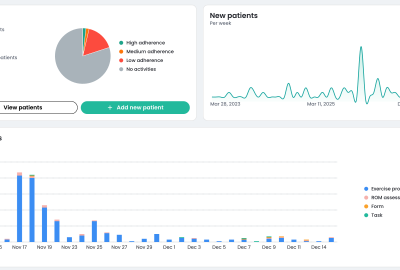The healthcare landscape is continuously evolving. However, despite technological advancements, physical therapy practices are still grappling with challenges, particularly those rooted in the payer-provider model.
Physical therapy workload issues often stem from a combination of high patient volumes, administrative tasks, and the complexity of individual cases. Many PTs are required to handle a large number of patients daily, often leading to a packed schedule with little time between appointments. This high patient load can be challenging, particularly when patients require intensive, individualized care. The need to balance hands-on therapy with documentation, treatment planning, and communication with other healthcare providers further compounds the workload. Administrative tasks, such as detailed record-keeping and compliance with insurance requirements, can be time-consuming and detract from the time available for patient care [source].
The Payer-Provider Model in Physical Therapy: A Bottleneck for Effective Care
In many health organizations, the payer-provider model governs how services are delivered and reimbursed. This model often results in a few PTs being responsible for a large number of patients. The implications are clear:
For therapists, heavy workloads can lead to burnout, reduced job satisfaction, and physical strain, potentially increasing the risk of injury or illness [source].
This can result in higher turnover rates, leaving clinics understaffed and further exacerbating workload pressures.
The impact of these workload issues is also significant for patients:
- Long Waiting Lists: With a limited number of PTs available, patients often face extended waiting periods before their first visit. This delay can exacerbate their conditions, making treatment more challenging and time-consuming.
- Short Therapy Sessions: Due to the high demand, PTs are forced to limit the time they spend with each patient. This time constraint can hinder the development of a thorough treatment plan, potentially compromising the quality of care.
- High Patient Volume: The sheer volume of patients means that PTs must juggle multiple cases simultaneously. This can lead to increased stress and burnout among therapists, further affecting the care they provide.
Ultimately, addressing workload issues in physical therapy is crucial to ensuring that both PTs and their patients can achieve the best possible outcomes. Strategies such as optimizing clinic operations, improving administrative support, and advocating for manageable caseloads are essential to alleviating these challenges- but they do not seem enough to handle to raising need for physical therapy.
Enter computer vision—a technology that’s poised to revolutionize the physical therapy sector. By integrating computer vision into physical therapy programs, clinics can streamline their operations, enhance the quality of care, and significantly reduce the burden on PTs. Let’s explore how computer vision can address these challenges and reshape the future of physical therapy.
Computer Vision: A Game-Changer in Physical Therapy
Computer vision technology, which enables computers to interpret and make decisions based on visual data, may be a transformative tool in physical therapy. Here’s how it can help PTs manage their workloads more effectively:
Decreasing In-Clinic Visits While Elevating Quality of Care
One of the most significant advantages of computer vision in physical therapy is could be reducing the need for frequent in-clinic visits. Through remote tracking and assessment, PTs can track a patient’s progress in real-time without the patient needing to be physically present. For instance, patients recovering from an injury can perform exercises at home while being monitored through a computer vision-enabled platform. The software can analyze their movements, provide instant feedback, and adjust the exercise plan as needed.
This remote approach could not only frees up clinic space for new patients but also may ensure that the quality of care remains high. In some cases, the precision and consistency of computer vision assessments might even surpass those of in-person evaluations, and may lead to better outcomes.
Reducing Waiting Times for the First Visit
By leveraging computer vision, clinics could streamline the initial assessment process, allowing patients to be screened and triaged before their first visit. This means that patients may begin their therapy journey sooner, reducing the time they spend on waiting lists. Early intervention is critical in physical therapy, as it may prevent conditions from worsening and reduce the overall duration of treatment.
Moreover, pre-visit screening might help PTs identify patients who require immediate attention, prioritizing their care and could ensure that those with less urgent needs are still supported without delay.
Initiating Therapy Before the First Visit
One of the most promising aspects of computer vision is its ability to initiate therapy before a patient’s first in-clinic visit. Patients can be provided with a tailored exercise program based on their initial remote assessment. The computer vision system could guide them through the exercises, trying to ensure proper form and technique. This early start might accelerate the recovery process and may reduce the number of in-clinic visits required later on.
Furthermore, this approach allows PTs to focus their in-clinic time on patients who need more hands-on care, while those who can manage their exercises independently receive the support they need remotely.
Optimizing Time Allocation for PTs
Time is a critical resource in physical therapy, and computer vision may help PTs distribute it more effectively. By automating the tracking and feedback process for patients who can perform exercises independently, PTs could devote more time to those who require manual therapy or more intensive in-person care. This may not only improve the quality of care for all patients but might also help prevent PT burnout by allowing therapists to manage their workload more efficiently.
With computer vision handling routine assessments and exercise supervision, PTs could spend more time on complex cases, ensuring that every patient could receive the level of care they need.
Reducing Recurring Visits for the Same Problem
Recurring visits for the same issue are a common challenge in physical therapy. Often, this is due to patients not adhering to their prescribed exercise routines or not following a post-rehab exercise plan as recommended. Computer vision could address this problem by providing continuous tracking and feedback after the rehabilitation phase ends, and might ensure that patients preserve their rehab achievements. This may reduce the likelihood of re-injury or regression, and may lead to fewer recurring visits and better long-term outcomes.
Decreasing the Risk of Musculoskeletal Pain
Computer vision may also play a preventive role in physical therapy by guiding patients to a movement focused exercise regime aimed at reducing MSK problems. For example, the technology can analyze a patient’s posture or movement patterns and may detect areas that need to be addressed. By targeting these issues early on, PTs might help patients avoid more severe injuries and may reduce the overall demand for therapy services.
Automating Treatment for Common MSK Problems
Finally, computer vision may be used to automate the treatment of common musculoskeletal (MSK) problems, such as lower back pain. These conditions often have standardized treatment protocols that may be effectively managed through computer vision. By automating these treatments, PTs could ensure that patients receive consistent, high-quality care while freeing up their time to focus on more complex cases.
Conclusion: The Future of Physical Therapy is Here
The integration of computer vision into physical therapy practices might offer a promising solution to many of the challenges faced by PTs today. By reducing the need for in-clinic visits, decreasing waiting times, and optimizing time allocation, computer vision could help PTs manage their workloads more effectively while maintaining—and might even improving—the quality of care they provide.
As the healthcare industry continues to evolve, embracing technologies like computer vision will be essential for organizations looking to stay ahead of the curve. The result might be a more efficient, effective, and patient-centered approach to physical therapy, and may benefit both therapists and patients alike.





